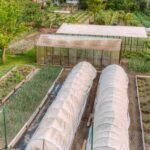Treated lumber is commonly used in outdoor construction projects such as decking, fencing, and raised garden beds. However, the question of whether treated lumber is safe for use in vegetable gardens has sparked a debate among gardeners and environmental enthusiasts. In this article, we will delve into the topic of treated lumber and its potential impact on vegetable gardens.
Treated lumber refers to wood that has been infused with chemical preservatives to enhance its durability and resistance to decay. This type of lumber is often used in outdoor settings where exposure to moisture and elements can lead to rotting and insect infestation. While it is widely used for various construction purposes, concerns have been raised about the safety of using treated lumber in vegetable gardens due to the potential leaching of chemicals into the soil.
The controversy surrounding the use of treated lumber in vegetable gardens has brought attention to the need for a better understanding of its composition, potential risks, and regulatory standards. In the following sections, we will explore different types of treated lumber, the chemicals used in their treatment, potential benefits and risks, existing regulations, alternatives, and tips for safe use.
By shedding light on these aspects, we aim to provide a comprehensive overview of the topic to help readers make informed decisions about using treated lumber in their garden projects.
Understanding Treated Lumber
Treated lumber refers to wood that has been infused with chemical preservatives to protect it from decay and insect damage. This process is commonly used in outdoor constructions such as decks, fences, and raised garden beds. There are different types of treated lumber, including pressure-treated wood and lumber treated with copper-based compounds.
The debate over whether treated lumber is safe for use in vegetable gardens revolves around the chemicals used in the treatment process. One of the main concerns is the potential leaching of these chemicals into the soil, which could then be absorbed by the plants. This raises questions about the safety of consuming vegetables grown in close proximity to treated lumber.
An important factor to consider when determining if treated lumber is safe for vegetable gardens is the type of chemicals used in the treatment process. The most common chemicals include chromated copper arsenate (CCA), alkaline copper quaternary (ACQ), and copper azole. Each of these has its own set of potential effects on soil, water, and plant health.
| Types of Chemicals | Potential Effects |
|---|---|
| Chromated Copper Arsenate (CCA) | Potential leaching of arsenic into soil |
| Alkaline Copper Quaternary (ACQ) | Lower risk of leaching compared to CCA |
| Copper Azole | Limited environmental impact due to lower copper content |
Benefits of Using Treated Lumber
Treated lumber is a popular choice for various outdoor construction projects, including decks, fences, and raised garden beds. It is treated with chemicals to resist decay and insect damage, making it a durable and long-lasting option for outdoor use. While the safety of treated lumber in vegetable gardens has been a topic of debate, there are several benefits to using treated lumber in this context.
- Durability: Treated lumber is known for its resistance to rot, decay, and insect infestation. This makes it an attractive option for constructing raised garden beds that can withstand the outdoor elements over an extended period.
- Longevity: Treated lumber has a longer lifespan compared to untreated lumber, which means less frequent replacement or maintenance. This can result in cost savings over time as the need for repairs or replacements is reduced.
- Cost Savings: While initially more expensive than untreated lumber, treated lumber’s durability and longevity can lead to cost savings in the long run.
However, despite these benefits, one may still wonder whether using treated lumber is safe for vegetable gardens. The potential risks associated with the chemicals used in treated lumber and their impact on soil and plant health are valid concerns that should be carefully considered before making a decision.
It is important for gardeners to weigh the benefits of using treated lumber against the potential risks and take necessary precautions to minimize any negative effects on their vegetable gardens.
Risks and Concerns
Treated lumber has been a popular choice for various outdoor construction projects due to its resistance to decay and insects. However, the question “is treated lumber safe for vegetable gardens” is a topic of debate among gardeners and environmentalists. When considering the use of treated lumber in vegetable gardens, it is essential to understand the potential risks and concerns associated with this material.
Chemicals such as chromated copper arsenate (CCA), creosote, and pentachlorophenol are commonly used to treat lumber, and these chemicals can pose risks to soil and plant health. The leaching of these chemicals into the soil can have detrimental effects on vegetable plants, potentially leading to contamination of the produce. Additionally, exposure to these chemicals through direct contact or inhalation during construction can also pose health risks to individuals working in the garden.
To address these risks and concerns when using treated lumber in vegetable gardens, there are some important considerations that should be taken into account:
- Consider using a barrier such as landscaping fabric or plastic sheeting between the treated lumber and the soil to minimize leaching of chemicals
- Opt for alternative materials such as naturally resistant woods like cedar or redwood
- Use caution when handling and cutting treated lumber, wearing protective clothing and a mask to avoid direct contact with the chemicals
It is important for gardeners to weigh the potential risks of using treated lumber against its benefits, such as durability and cost savings. However, considering alternative materials may provide a safer option for constructing raised beds or other garden structures in vegetable gardens. Ultimately, it is recommended that individuals thoroughly research and consider expert opinions before making a decision on whether or not to use treated lumber in their vegetable gardens.
Regulations and Standards
When it comes to using treated lumber in vegetable gardens, it is crucial to consider the existing regulations and standards governing its use. These regulations are put in place to ensure the safety of individuals, as well as the environment, when using treated lumber for construction or gardening purposes.
Existing Regulations
The regulations regarding the use of treated lumber in vegetable gardens vary by region and country. In the United States, for example, the Environmental Protection Agency (EPA) has established guidelines for the use of treated lumber, particularly when it comes into contact with soil where food is grown. These guidelines specify which types of treated lumber are approved for use in particular settings and outline how they should be handled and disposed of to minimize environmental impact.
Government Oversight
Government agencies play a significant role in monitoring the use of treated lumber in vegetable gardens. They conduct research, set guidelines, and enforce regulations to ensure that treated lumber products meet safety standards. It is essential for gardeners to stay informed about these regulations and seek out certified products that comply with government oversight.
Environmental Organizations
In addition to government oversight, environmental organizations also play a key role in advocating for safe practices when it comes to using treated lumber in vegetable gardens. These organizations provide education on potential risks associated with treated lumber and advocate for sustainable alternatives that minimize harm to the environment and human health.
By being aware of existing regulations and standards related to treated lumber use in vegetable gardens, gardeners can make informed decisions about whether or not to use this material while considering their safety and environmental implications.
Alternatives to Treated Lumber
When considering the use of treated lumber in vegetable gardens, it is important to explore alternative materials for constructing raised beds and garden structures. While treated lumber may offer durability and longevity, some individuals have concerns about the potential health risks and environmental impact associated with its use in a garden setting. Fortunately, there are several alternatives that can be considered when building or renovating a vegetable garden.
One popular alternative to treated lumber is using naturally rot-resistant woods such as cedar or redwood. These types of wood contain natural oils that make them resistant to decay, eliminating the need for chemical treatment. While they may be more expensive upfront, the avoidance of potentially harmful chemicals can outweigh the initial investment for many individuals.
Another option is using composite materials made from recycled plastics and wood fibers. These materials are designed to mimic the look of traditional wood while offering resistance to rot, insects, and decay. Additionally, composite materials typically require minimal maintenance and are available in a variety of colors and styles, providing flexibility in design options for vegetable gardens.
Lastly, some gardeners opt for untreated lumber or other non-wood materials such as metal or stone for their raised bed construction. Untreated lumber can be used in conjunction with a protective barrier such as plastic sheeting to prevent direct contact between the wood and soil, reducing the risk of chemical leaching. Metal or stone constructions offer durability and aesthetic options that may appeal to those seeking alternative materials for their vegetable gardens.
Consider Using Alternative Materials When Constructing Your Vegetable Garden Beds
| Alternative Materials | Benefits |
|---|---|
| Cedar or Redwood | Naturally resistant to decay without chemical treatment |
| Composite Materials | Resistance to rot, insects, and minimal maintenance required |
| Metal or Stone | Durable options that provide aesthetic appeal |
Tips for Safe Use
When considering the use of treated lumber in vegetable gardens, it is essential to prioritize safety to ensure the health of both the soil and plants. While there is ongoing debate about its safety, there are measures that can be taken to minimize potential risks and maximize the benefits of using treated lumber in a vegetable garden setting.
Choose the Right Type of Treated Lumber
One important aspect of using treated lumber in vegetable gardens is to select the right type of treated wood. Look for lumber that is certified as safe for use in areas where food is grown. This may include wood that has been treated with safer alternatives such as copper-based compounds or borates, which are less likely to leach harmful chemicals into the soil.
Line the Interior of Raised Beds
To further reduce the risk of chemical leaching, consider lining the interior of raised beds constructed with treated lumber. Use a thick plastic barrier to create a physical separation between the treated wood and the soil where vegetables will be planted. This extra layer provides an added level of protection against potential contact with any chemicals from the treated lumber.
Monitor Plant Health Regularly
Keep a close eye on the health and growth of plants in vegetable gardens constructed using treated lumber. Look out for any signs of stress or unusual patterns indicative of potential issues related to chemical exposure. Regular monitoring can help identify and address any concerns early on, ensuring that plants remain healthy and safe for consumption.
By following these tips for safe use, it is possible to minimize potential risks when using treated lumber in vegetable gardens. Additionally, consulting with experts and conducting thorough research can provide valuable insight into best practices for utilizing treated lumber while prioritizing safety and plant health.
Conclusion
In conclusion, the debate over whether treated lumber is safe for use in vegetable gardens is a complex and multifaceted issue. While treated lumber does offer benefits such as durability and cost savings, there are also valid concerns regarding the potential health risks and the leaching of chemicals into the soil.
The type of chemicals used in treating lumber, as well as the specific regulations and standards in place, play a critical role in determining the safety of using treated lumber in vegetable gardens.
It is important to note that while there are risks associated with using treated lumber in vegetable gardens, there are also measures that can be taken to minimize these risks. This includes selecting alternative materials for constructing raised beds and garden structures, as well as following guidelines for safe use. Ultimately, the decision to use treated lumber in a vegetable garden should be made carefully, taking into consideration all potential risks and benefits.
In light of the potential risks associated with treated lumber, it is advisable to exercise caution when using this material in vegetable gardens. It may be prudent to seek out expert opinions and guidance from local government agencies or environmental organizations before making a decision. By weighing all available information and considering individual circumstances, gardeners can make informed choices about whether treated lumber is safe for use in their vegetable gardens.
Frequently Asked Questions
Is It OK to Use Pressure Treated Wood in a Vegetable Garden?
Using pressure-treated wood in a vegetable garden is a topic of debate. While the chemicals in the wood can potentially leach into the soil, studies have shown that the risk of exposure to harmful levels of these chemicals is low.
Can Treated Lumber Be Used as Tomato Stakes?
Treated lumber can be used as tomato stakes, but there are some precautions to consider. Avoid using freshly treated lumber near edible plants and allow the wood to weather for a season to reduce chemical leaching.
What Wood Should Not Be Used in a Raised Garden Bed?
Certain types of wood should be avoided when building raised garden beds. These include woods that are prone to rotting quickly, such as cedar and redwood. These types of wood may not last as long as other options like pine or fir.

If you’re looking to get into vegetable gardening, or are just looking for some tips on how to make your current garden better, then you’ve come to the right place! My name is Ethel and I have been gardening for years. In this blog, I’m going to share with you some of my best tips on how to create a successful vegetable garden.





